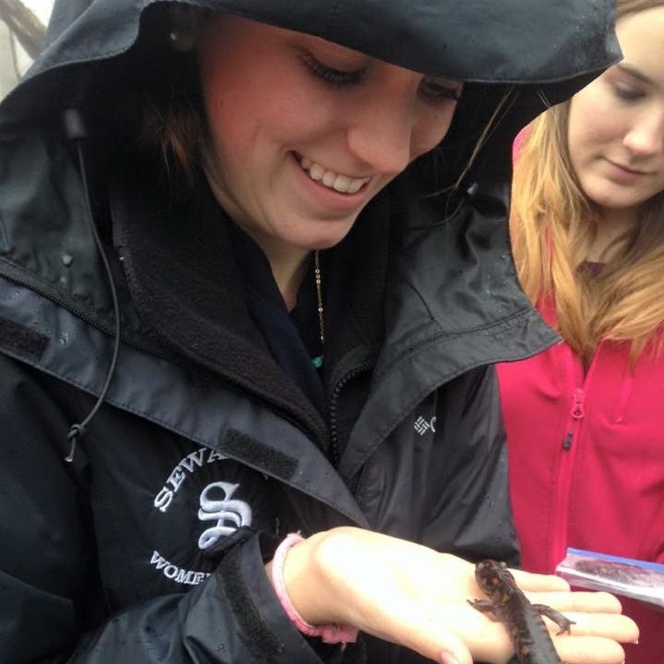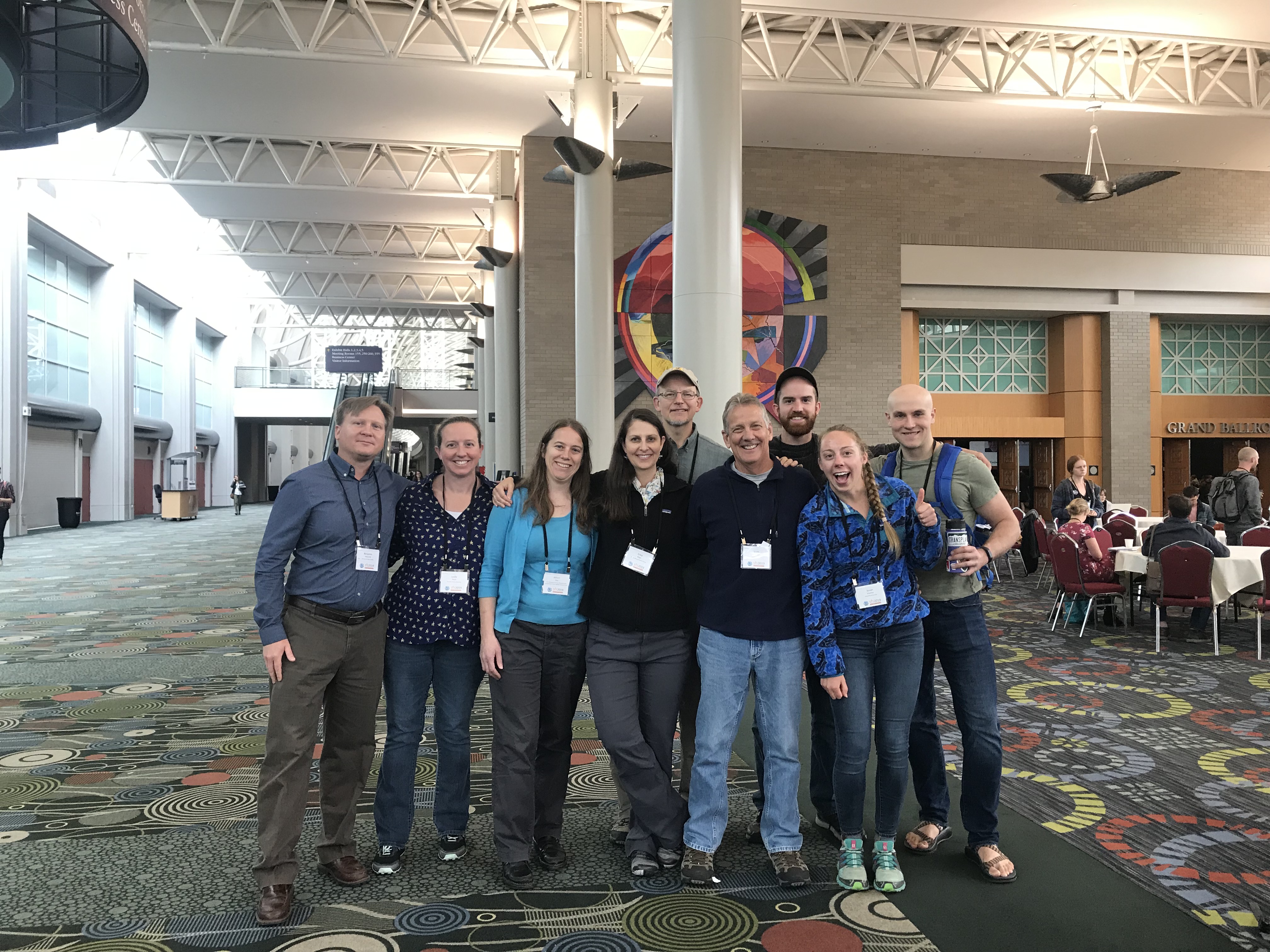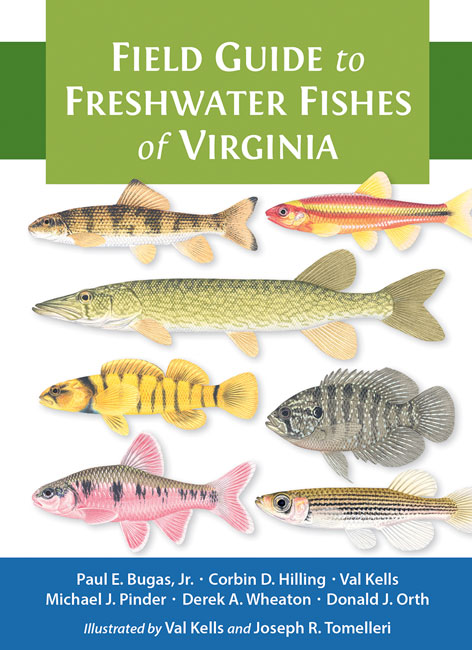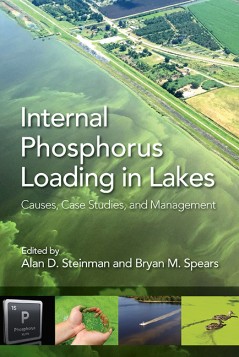In the Drift: Issue 36, Winter 2020
In this issue
- FPOM - short news and resources
- Freshwater Science Article Spotlight
- Chuck's Corner: To p or not to p
- Tribute to Dr. Scott A. Wissinger
- Review: The Field Guide to Freshwater Fishes of Virginia
- Review: Internal Phosphorus Loading in Lakes
Dear Society for Freshwater Science,
In this new issue of In the Drift, we have filled your drift nets with unique content and the latest news from the Society for Freshwater Science. As always, we thank all those that contributed to this issue. If you have any content you would like to share with the Society, send us an email at pip@freshwater-science.org.
Warm wishes and we hope to see you this spring in Madison, WI!
Ross Vander Vorste, newsletter editor Ali Chalberg, co-editor Brad Morris, co-editor
FPOM
SFS quick links and resources collected from "the drift"
- The 2020 SFS Fellows and Career Awards announced!
- President's Environment: coping with COVID-19
- See the latest issue of Freshwater Science
- A new Making Waves podcast hosted by Susan Washko talking with Drs. Howard Whiteman, Sarah Whorley, and Kate Boersma about taking students on field trips.
- Stay Fresh! a compilation of new research in freshwater sciences.
- Classified Ads - job opportunities and workshops in freshwater science
Article Spotlight
By Ali Chalberg and Brad Morris

Salamander Fight Club A hot topic in freshwater science is climate change, and many scientists are curious about the ecological changes that will occur due to this phenomenon. In this article, we spotlight a study published in FWS that investigated the effects of climate change on salamander behavior. More specifically, the research explores the effects of elevated temperatures and the potential effects of increases interspecific aggression between Appalachian stream salamanders. 156 different stream salamanders consisting of three species: Blackbelly Salamander (Desmognathus quadramaculatus), Ocoee Salamander (Desmognathus ocoee), and Seal Salamander (Desmognathus monticola) were collected in Monroe County, Tennessee.

Figure 1. Bissell and Cecala (2019) recorded video of 156 different stream salamanders comprising three species to assess the effect of increased temperature on salamander behavior. Artist Credit: Maddy Keller
This project was spearheaded by an undergrad, Kailey Bissell. Kailey now works as a School Programs Education Specialist for Mote Marine Laboratory & Aquarium. Her advisor on this project was Dr. Kristen Cecala, an Associate Professor at Sewanee: The University of the South. Here she teaches Ecology and Environmental Science classes along with Herpetology.
Previous studies by Dr. Cecala and her colleagues at the Tennessee Aquarium and Appalachian State University suggested that there was a change in behavior with the change in temperature. “[The climate] is changing in reasonably predictable ways, but when you add these levels of complexity … things start to get very complicated very quickly” stated Dr. Cecala. With these ideas in mind, they decided to carry out this study.

Kailey Bissel holding a Spotted Salamander (Ambystoma maculatum) Photo Credit: Todd Pierson
Kailey, was in charge of setting up the tanks, cameras, and lighting. These tasks were difficult because salamanders are nocturnal, camera shy, and adept at escaping from enclosed spaces. Therefore, Kailey needed to use red lights instead of bright aquarium lights, which allowed the cameras to work while not disrupting the salamander’s nocturnal behavior. While looking at the recordings they determined what behavior was considered to be aggressive behavior. Another struggle was making the cages salamander proof to prevent them from escaping.
Hours went into observing the salamanders on video. While looking at the recordings they determined what behavior was considered to be aggressive. They even had to pull outside people to watch the videos when they were unsure of how to classify a behavior. Throughout the hours of observation, they saw many behaviors some of which could be described as them “acting like puppies” while they pile on top of one another. The behaviors were not always cut and dry aggression but could be as simple as a head flick. Upon analyzing the data collected from the recordings, Kailey and her colleagues concluded that as temperature increases the aggressive behavior also increased.
Not only was the lab work interesting but Dr. Cecala also described a particular field event. It was beginning to get dark out and her field team was about to head back for the night when they stumbled upon a wet wall full of salamanders. She said that this is still one of her best field experiences. She attributes the sheer number of salamanders that night to the salamanders being nocturnal behavior.
Climate change research is a highly important and complex field for our current day and age. However, projects such as this make a large overwhelming topic more obtainable to students.
In our interview, Dr. Cecala offered some advice to students interested in field studies. She says, “be open to a diversity of opportunities even if it doesn't sound like it is directly related to your goals...those skills are likely to be transferable to many other positions or contexts, and it is hard to identify in advance where a position or opportunity may lead you!”
Many students have worked with Dr. Cecala doing research on various amphibians and reptiles. Their current research can be seen on her website.
To p or not to p, that is the question
Freshwater ecologists have been trained for decades in how to design studies, match research questions with appropriate statistical models, and interpret the results of statistical tests. We have learned how to apply different flavors of analyses of variance (plain vanilla, with covariates, blocked, split, nested, and repeated) when conducting either manipulative or natural experiments and how to partition and report sources of variation. We have learned how to use various types of regression analyses to describe and quantify associations between response variables of interest and predictor variables. We have learned how to ensure that our data meet the assumptions of these parametric tests and use non-parametric equivalents if we cannot meet those assumptions. More recently, we have learned to distinguish random effects from fixed effects when selecting specific model structures. Over my professional life, we have learned to use increasingly sophisticated procedures to conduct these tests. And, we have been blessed with a cornucopia of procedures available in R and other statistical packages.
A basic output from many of these procedures is p, the nearly sacred number that, if small enough, may convince reviewers to recommend publication of our work, but if too large (i.e., larger than the mystical threshold of 0.05), cause the same reviewers to relegate our hard work to the dust bin of never to be read studies. It turns out that p > 0.05, a core criterion applied to nearly all statistical tests, has been vexing statisticians, ecologists, and other scientists for decades (e.g., see Yoccoz 1991). We know, for example, that p is strongly influenced by sample size, and simply reporting p (and whether it is greater or less than 0.05) tells us little about what we really care about - the magnitude of effect an x-variable has on a response variable. Concern over p < 0.05 has been simmering beneath the surface of science like a geyser, and that geyser has finally erupted. In a 2016 statement summarizing concerns regarding the interpretation of p values, the American Statistical Association (ASA) primed the geyser (Wasserstein and Lazar 2016); and last March, the geyser erupted (Wasserstein et al. 2019). That month, the ASA published a series of papers in a special issue of The American Statistician called “Statistical inference in the 21st century: A world beyond p < 0.05”. The lead editorial (Moving to a world beyond “p < 0.05”) by Wasserstein et al. (2019) lays out the problem, lists several “don’ts”, including the recommendation to stop using the term “statistically significant” and similar terms entirely. Equally important, the editors point to the 43 papers published in the special issue to help guide how we should use p and other statistical output in the future. p, itself, is clearly still useful, but “statistically significant” seems to have been dealt a mortal blow.
As the Editor of Freshwater Science, I think the recommendations laid out by Wasserstein et al. (2019) are spot-on and long overdue. These changes should liberate us from the tyranny of “p < 0.05”, or any other arbitrary level of p for that matter; but by leaving “p < 0.05” behind us, we will need to be more thoughtful, rational, and scientific in how we use statistics to guide our inferences. I look forward to Freshwater Science receiving submissions that use statistical tests as one component of a balanced, weight-of-evidence approach that should lead to more robust and defensible inferences than have often been made in the past. I urge you to read the Wasserstein et al. (2019) editorial and as many of the papers in the special issue as you can. Then, when submitting to Freshwater Science, p freely, but p wisely.
Wasserstein, R. L., and N. A. Lazar. 2016. The ASA’s Statement on p-Values: Context, process, and purpose,” The American Statistician 70:129–133. Wasserstein, R. L., A. L. Schirm and N. A. Lazar. 2019. Moving to a world beyond “p < 0.05”, The American Statistician 73:Supplement 1:1-19. Yoccoz, N.G. 1991. Use, overuse, and misuse of significance tests in evolutionary biology and ecology. Bulletin of the Ecological Society of America. 72:106-111.
A Tribute to Dr. Scott A. Wissinger
By Erika Bilger

Dr. Scott Wissinger, Professor Emeritus at Allegheny College, endowed professor, Fulbright Scholar, Erskine Fellow, and long-time NABS/SFS member, passed away at age 65. He chaired both the Biology and Environmental Science departments at Allegheny College in Meadville, Pennsylvania and was an adjunct fellow in Freshwater Ecology at the University of Canterbury in Christchurch, New Zealand. A naturalist with a strong sense of place, Scott invested his time and talents in the world and people around him with intensity.
Scott was a central Pennsylvania native and graduate of Susquehanna University, and he cherished his childhood streams and rivers throughout his life. This, along with his seminal Ph.D. work on dragonfly life histories and ecology at Purdue University, set him on a path in freshwater ecology. In 1988, Scott joined Bobbi Peckarsky at Rocky Mountain Biological Lab (RMBL) for a few weeks, during which they sampled the then unknown benthic invertebrate communities in alpine ponds around the Mexican Cut. In the same visit, Scott collected data on young-of-year Ambystoma salamanders from several ponds. The data from this initial trip inspired a proposal, and he was granted an NSF Presidential Young Investigator Award. Scott returned to RMBL every subsequent summer, maintaining collaborative research on salamander population dynamics, wetland macroinvertebrate communities, and caddisfly life histories and roles in ecosystem function.
Scott grew a successful research program at a private liberal arts college with roughly 2000 students, all undergraduates. Over his 32 years at Allegheny College, he advised nearly 200 “comp” (senior project) students and supported 50 NSF-funded undergraduate researchers at RMBL. His students co-authored publications and presentations, including many in our society’s journal and at NABS/SFS meetings. He relished seeing students excited about ecology, which motivated various research questions, topics, and directions he covered over his career. An outstanding teacher in the classroom, lab, and field, Scott continued teaching seminar courses and advising students after his retirement in 2018. His former students contribute to freshwater science in all levels of government, consulting, non-profit organizations, and academia, and are a significant and lasting embodiment of his legacy.
Scott’s successes in the field of freshwater ecology are matched by his personal connections with students and colleagues (and people in general). His blend of infectious enthusiasm for science and penchant for personal connections made him a unique and adored professor and colleague. He delighted in championing aspiring scientists with practical encouragement and had a way of inciting students to be better. He was known not just for his role as an academic advisor, but also his ability to listen and advise students on life. The connections he formed with students continued long after graduation through career advice, reference letters, research collaborations, visits, and kitchen table conversations. Scott could seamlessly transition from discussion about the evolutionary trade-offs of growth and reproduction in caddisflies to the joys and trials of raising children. For those of us lucky to have him as our advisor, he continued his mentor role in our lives, in some cases decades after leaving Allegheny.
While Scott excelled at making one feel special, it was always clear he absolutely cherished his family and love of his life: wife Sue, son A.J., daughter-in-law Jamie, and new baby granddaughter, Charlotte. He took great care to stay in touch with his 5 younger sisters, nieces and nephews, and his mom. Scott had many interests and talents; he held various service positions, coached baseball, ran, fly fished, biked, and enjoyed theatre and music festivals. He was many things to many people, perhaps only possible because Scott never slept and was always, always late. He could identify mountain wildflowers in the Rockies as well as the fishes of a northwest Pennsylvania stream. And, he had a particular affinity for planting trees, having at least one of every species native to Pennsylvania growing on his property.
At this past SFS meeting in Salt Lake City, former students and colleagues gathered to honor, roast, and congratulate Scott on his retirement from Allegheny College. We are incredibly grateful for this time and immensely sad to have suddenly lost our mentor and friend just a few months later on October 5. We will miss his brilliant mind, proclivity for wearing purple, endless razzing and practical jokes, the reassurance of his smile, and his unfailing loyalty. Yet, his infectious ardor for experiencing the world around him transcends his absence, and his academic tree is truly a forest on the freshwater ecology landscape.

Scott Wissinger with former lab members at #2019SFS (Pictured from l to r: Ben Holcomb, Leslie Rieck, Allison Roy, Erika Bilger, Howard Whiteman, Scott Wissinger, Mike Vlah, Susan Washko, and Jared Balik) Photo credit: E. Bilger.
Book Reviews

The Field Guide to Freshwater Fishes of Virginia
Authors: Paul E. Bugas, Jr., Corbin D. Hilling, Val Kells, Michael J. Pinder, Derek A. Wheaton, and Donald J. Orth Illustrated by Val Kells and Joseph R. Tomelleri
-- reviewed by Dr. Stephen McIninch, Virginia Commonwealth University
The Field Guide to Freshwater Fishes of Virginia is a welcome addition to the library of field guides that compels us to be outside more and to learn what we can while there. Anyone interested in the fish fauna of the Commonwealth of Virginia would do well to include this in their collection. The guide provides brief and meaningful information on the diversity and methods for observation and handling of fishes. These activities provide the most information and enjoyment when one is able to identify the specific species of interest. Species identification is perhaps the most important role of the field guide.
The Introduction section explains the organization and layout of species accounts and then introduces the reader to the world of freshwater fishes, focused primarily on Virginia. The physiographic composition of the Commonwealth as well as drainage variability and the associated fish faunas are briefly described. The brevity sometimes results in over- extension such as the characterization of the large majority of waters within the Coastal Plain as “acidic, dark, and low in oxygen”. Overviews on the aquatic habitat types and ecological importance of fishes is followed by a section on the contribution of these fishes to Virginia’s economy.
The section on fish watching, photography and keeping of fishes will surely add people to the enjoyable arts of wildlife watching. As the authors point out, one can “make a hobby of watching fishes”. The Guide also includes sections on catching fishes (outside of standard rod and reel angling) and both photography and keeping of fishes. A few of the authors are Virginia Department of Game and Inland Fisheries employees and they do well to mention existing limitations on collection of fishes as well as point to the proper authorities when removing fish, especially protected species, from their habitats.
Management and conservation of fishes is presented with brief subsections that range from angler surveys and tagging methods to genetics and hatchery stockings. Most of these tasks are targeted (what does species X eat?, where does species Y go?, how stable if the population of species z?). One aspect omitted is the role that fishes play in many biomonitoring programs around the world and in Virginia.
Prior to the species accounts, a section on fish anatomy provides readers with explanation of characters used to describe fishes. Description of basic anatomical features are supported with illustrations gleaned from Freshwater Fishes of Virginia (Jenkins and Burkhead 1994). Additional information on diagnostic characteristics not often used in the species accounts (i.e. fin ray and spine counts, scale counts and lateral line variables) are included. A Key to fish families of Virginia follows and directs to the family accounts.
The format of species accounts is an improvement over larger (regional) guides where descriptions, information, pictures, and maps may be separated in different parts of the book. Following a brief introduction of each family, formal scientific and common names are given (as well as some additional colloquial names for some species. Descriptions include general notes on characteristics such as overall body form and fin placement but also include identifying characters related to pigmentation patterns and variation in coloration. Account subsections in addition to Description include, Reproduction (timing and habitats); Food – broad dietary tendencies; and a Notes section where the authors include various interesting aspects of biology, distribution, behavior, management or other items of interest. In some cases the protected status (federal or state-wide) are noted. For the amateur fish observer and/or aquarist this guide would have benefited from a more readily apparent way to denote protected species.
Most of the species accounts are accompanied by an illustration of the species. These illustrations are a major feature of this book. Many of the species illustrations are depicted in the species’ most colorful form, usually during the spawning season. At this time, these fishes are certainly at their most spectacular but this is short-lived for many species and thus not representative of what may be considered a non-breeding coloration pattern. This is most evident in the two largest families Minnows and Darters but less so for the Sunfishes. The size ratios, fin placement, and feature detail in the illustrations are remarkable (in many cases scale counts and fin rays counts are accurate). Overall coloration is more variable. Details of bar placement, stripes, stippling, etc.. is very good to excellent but some background coloration in many of the accounts appears to be washed out or faded. The two species chosen to front the Species Account section, Riverweed Darter and Candy Darter, are also represented by photographs, and indicate color variability. A more uniform treatment among seasonal condition or an indication of stage at coloration would assist an observer out of spawning season. Similarly, lamprey species are only illustrated in adult form but may be encountered more frequently as ammocoetes (especially the brook lampreys).
Some species of fish are difficult to positively identify due to similarities with like species. Because many of these species share similar characteristics and coloration patterns, they are generally not both illustrated. Those like-species that inhabit different drainages will be discernable by place of capture. Others would have benefitted from having comparative illustrations that point out differences.
Range maps and briefs on Size, Habitat, Abundance, and Status complete the species accounts. Size represent the adult size range. Habitat indicates descriptive habitat characters such as temperature, size of water body, and flow lentic versus lotic. Abundance reflect numbers commonly found as Rare, Uncommon, Common, and Abundant. Status is stated as Native to Virginia or Introduced into Virginia. This is an oversimplification of a diverse fish fauna. In many cases (not all), the Notes section contains information on native drainages, otherwise if it is possible that a species is native in any part of any drainage, it is listed as Native. Someone observing a Green Sunfish from any drainage on the Atlantic slope should be able to acknowledge that it is an introduced fish.
My copy of this field guide is already quite dog-eared and I imagine that I will accidently drop it into the water at least once during future field seasons. The wonderful illustrations along with useful descriptions will allow those seeking to build their ‘life-list” of freshwater fishes. I would suggest that the authors add a species checklist in the 2nd edition for just that purpose.

Internal Phosphorus Loading in Lakes: Causes, Case Studies, and Management
Editors Alan D. Steinman and Bryan M. Spears
-- Reviewed by Dr. Gary A. Lamberti, University of Notre Dame
Phosphorus (P) is among the most biologically active yet geologically scarce elements on the planet. Therefore, its release from lake sediments (often called ‘internal P loading’) is of paramount importance for the ecology and management of freshwater lakes. Not only is P often the cause of eutrophication and harmful algal blooms, internal loading can prevent lake water quality from recovering for decades even if external P loading is controlled. Yet, without this essential element of ATP, life would no longer exist. In this book, editors Steinman and Spears bring together an international cast of experts to summarize the state-of-knowledge of P loading and cycling in lakes around the world.
In a well-crafted treatment of the topic, the book first introduces the problem of P loading, its measurement, driving factors, and mathematical modeling. In the second section, 17 chapters are devoted to important case studies of P dynamics in lakes representing 13 different countries and 5 continents. Finally, the book concludes with synthetic chapters summarizing the global knowledge of P loading and recommendations for its management on a changing planet. This comprehensive treatment of P loading in lakes is a welcome, and long overdue, contribution to a critical ecological process that will guide the field of P management for decades to come.



